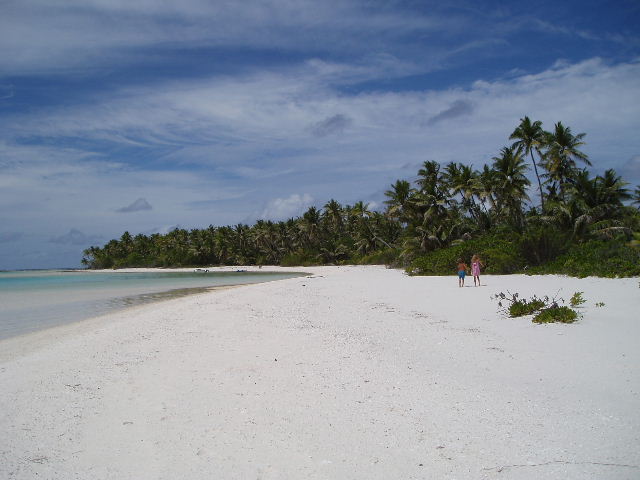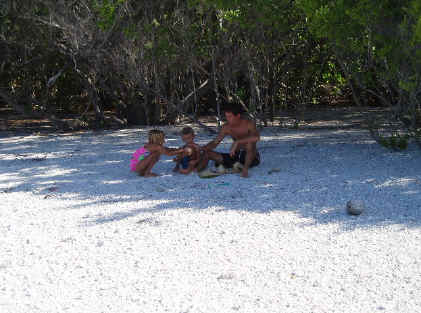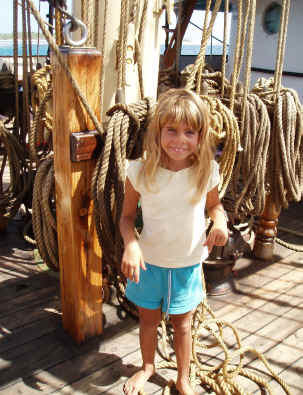

Rarotonga Approach . After a fast 3 days, we completed the 400 mile
passage from Bora Bora just before a storm blew in and closed the harbor.
Our first Mahi Mahi made several great dinners.


Left: The tiny fishing harbor filled up quickly as the weather
turned blustery. A crisscross of mooring lines off the sterns and anchor
lines off the bows made leaving a difficult experience. When the wind blew
in, getting off the boat onto the seawall proved a challenge. Right:
In most places the lagoon is shallow and corally. Lush green vegetation
covers the mountainous island and lines the shore.


The Cultural Village, an outdoor museum, taught us about traditional weaving,
coconuts, fishing, food, dance and music. The kids got hands on experience with the drums, making palm frond bracelets and trying local
food. Did you know? Coconuts are used in all stages of growth for
different things like food, fiber and drinking. Plates woven of palm
fronds are still used at 21st birthday celebrations. Coconut milk is the
liquid squeezed out of shredded ripe coconut. Coconut water is the
"7up" tasting liquid in the center of a young nut.


Cruising kids-not the easiest subject for a posed photo. The
botanical garden held the interest of all. Back row: Mia (Omaze),
Ellie, Sophie (Dolphins), Lucia (Omaze), Louisa (Dolphins), Carter. Front
row: Emma and Jack (Dolphins)

The market on Saturday morning hosted ice cream stands, local cuisine,
locally grown vegies and tourist souvenirs. Of course, the kids were most
interested in the cotton candy.


For the first time since home, we're in an English speaking country.
The kids played with locals easily. Everyone seemed to friendly and
inviting. Tuesday night is dance rehearsal night for the local troop, from
the little beginners to the professional hotel performers. All are welcome
to participate in the fun before and the challenge of swinging those hips.
Ellie is 4th from the left, thoroughly enjoying herself. She hasn't
stopped wiggling ever since.

Word got out that most of the yachts in Rarotonga were on their way to
Palmerston. Friends and families of Palmerston residents brought box after
box of food and hardware to be delivered. Alex from Sanuk hands
boxes down the ladder to Pete who heaves them to Rob (Dolphins) to be loaded on
the boats.

Palmerston Atoll. Barely rising out of the sea, this unique
island has a culture all it's own and people unlike any we've ever met.
The 270 mile trip there was fast and furious. We had several minor
equipment failures and quite a lot of upset tummies. Land looked pretty
good.

Motu in the Palmerston lagoon. These small islands are uninhabited and
used for recreation and growing taro root. Pictures can't do justice to
the beauty. The kids collected shells, played with crabs, spotted eels and
made forts in the bushes.


The motus are also home to Tupa crabs which are quite tasty. They live on
land and come out at sunset to feed. You just walk along and scoop them
up. We never went hungry here. Almost everyday a feast was given at
one home or another. Out of their local resources of parrot fish,
chickens, coconut and taro an amazing amount of dishes can be prepared.


Pete at play. Left: Real men must start fire with sticks. We
did see smoke, but dinner would have been eaten raw. Right: The
kids and Pete play with hermit crabs and open coconuts on a deserted tropical
island. This is what it's all about.


Parrot fish make up the majority of the local diet. Our hosts,
Edward, John, David and Shirley come back with their catch for the day.
For just a meal, they use spears, but for a feast they set out the nets and
catch 60 at a time.


Umus, the traditional underground oven used to roast fish, meat and
vegetables, are still used often to save propane. The method of wrapping
food in palm and taro leaves is still being used, with the addition of metal
baking dishes. Edward and his brother in law, Nu, prepare the parcels of
fish and load the ovens. The women prepared coconut bread dough in the kitchen
to be baked in the second oven.

Picturesque Palmerston.


Rain provides the only fresh water on the island. They run generators from
6 a.m. until noon and 6 p.m. until midnight, which gives the school power and
keeps the parrot fish frozen. Left: John gets water from the
cistern to help feed the pigs. Right: Edward's family home
where we were treated like honored guests in the outdoor living room.


The "Picton Castle's" arrival enticed us to stay another week to enjoy
the tours, the parties and the new faces.
And off we go to Tonga!